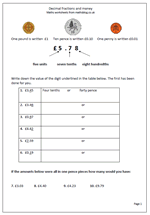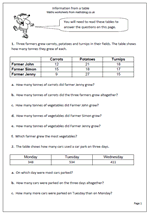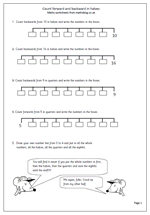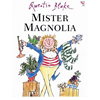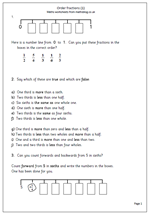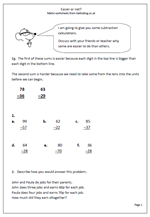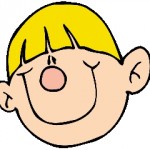 To be able to successfully help your child with maths at home it is important to have a good idea of what is expected in school. Remember, we divided all the maths content into 7 strands. Let’s take each of the strands in turn to see what the Primary Framework for Mathematics suggests for children aged between 5 and 6 years old.
To be able to successfully help your child with maths at home it is important to have a good idea of what is expected in school. Remember, we divided all the maths content into 7 strands. Let’s take each of the strands in turn to see what the Primary Framework for Mathematics suggests for children aged between 5 and 6 years old.
Counting and understanding number
By the end of year 1 children should
• know the number names (one, two, three etc) up to at least 20 and tens up to 100
(eg twenty, thirty, forty etc).
• be able to count up to 20 objects reliably. If the objects (eg buttons on a tray) are moved around they should be able to say that the total number has not changed without recounting. (Younger children will count them again if they have been moved around.)
• be able to read and write numerals up to 20
(eg 3, three, 4, four, 5 five, etc).
• be able to place numbers on a blank number line in the correct order.
• be able to say the number that is one more than or one less than any given number up to 20
(eg one less than 7).
• be able to say the number ten more than or ten less than a multiple of 10
(eg ten more than 30).
• recognise the equals sign (=) and understand it means “..is the same as..”
• use the terms, half and quarter in a practical sense
(eg give me a quarter of the orange).
Knowing and using number facts
By the end of year 1 children should
• know addition facts up to a total of 5
(eg 3 + 2).
• know all pairs of numbers with a total of 10
(eg 1 and 9, 2 and 8 etc).
• be able to work out subtraction facts from the addition facts they know.
(eg 5 -2 = 3 because 3 + 2 = 5)
• be beginning to count on and back in twos, fives and tens.
• know the doubles of all numbers up to 10
(eg double 6 is 12).
Calculating
By the end of year 1 children should
• know that addition can be done in any order.
• be able to write simple number sentences using the + and = signs
(eg 3 + 4 = 7).
• use practical methods (eg using counters) to help with addition of a 1-digit number to a 1-digit or 2-digit number
(eg 10 + 4 =).
• use informal written notes to help with addition
(eg jotting down the answer to adding 2 numbers before trying to add the third).
• understand that subtraction can mean ‘take away’.
• understand that subtraction can mean ‘find the difference between’.
• be able to use practical methods to help with subtraction of a 1-digit number from a 1-digit number
(eg using counters).
• use informal written notes to help with subtraction
(eg jotting down 5 circles and crossing out 3 for 5 – 3).
• be able to write simple number sentences using the – and = signs
(eg 7 – 4 = 3).
• understand and use the vocabulary related to addition and subtraction, including: more, add, sum, total, altogether, equals, =, take away, subtract, difference between, how much more/less, how many are left?
• be able to combine groups of 2, 5 and 10 in a practical situation
(eg combining marbles into groups of 5 marbles).
• be able to share a group of objects into 2 equal parts
(eg sweets shared equally).
Understanding shape
By the end of year 1 children should
• be able to visualise and name common 2-D shapes, including circle, triangle, rectangle and square. This includes activities such as “Find a shape which has 3 corners and 3 sides”.
• be able to visualise and name common 3-D shapes, including, cube, cuboid, sphere, cone and cylinder. This includes activities such as describing the properties of a shape by the feel of it, before seeing it.
• be able to make patterns and pictures with 2-D shapes and make models with 3-D shapes such as Lego.
• begin to describe the position of shapes, using terms such as: over, under, underneath, above, below, outside, inside, in front, behind, beside, before, after, next to, opposite, between, middle, centre, edge, corner, top, bottom, side. This is where activities such as moving furniture around a toy house are very important or placing counters on a board game.
• be using everyday language to describe direction, such as: left, right, up, down, forwards, backwards, sideways, across, along, through, to, from, towards, away from.
• begin to be able to describe movements in a straight line and turning. At first turning will only be by whole and half turns but it is important to recognise shapes that turn about a point, such as a pair of scissors.
• Once again it must be emphasised that most of this work is done orally with practical equipment. Toys, board games, may seem like playing to us but are invaluable learning experiences.
Measuring
By the end of year 1 children should
• understand and use the basic vocabulary related to length, mass and capacity.
For length: long, short, tall, high, low, wide, narrow, deep, shallow, thick, thin, far, near and words of comparison eg longer.
For mass: weight, weighs, heavy light, balances.
For capacity: full, empty, half full, holds.
• be able to make direct comparisons between two items eg comparing the length of two pencils, the weight of two parcels, the capacity of two cups. A set of balance scales is very useful for this kind of work.
• begin to use non-standard measures
(eg the jug holds 6 cups of water, the table is about 7 rulers long).
• be making sensible estimates and guesses related to length, mass and capacity. Standard units such as cm, km, kg are not used at this stage.
Using and applying maths
By the end of year 1 children should
• solve problems involving counting, addition, subtraction, doubling, halving, measures and money
(eg a toy shop, paying and giving change with numbers up to 10).
• describe and solve simple puzzles or problems
(eg How many ways can you score 4 rolling two dice?).
• sort information, shapes or objects and display the results using pictures
(eg sort cubes by colour).
• describe simple patterns involving numbers or shapes
(eg continue a pattern of repeated squares and circles).
• describe ways of solving a puzzle or problem orally
(eg talk about or draw what coins could be used to make 6p).
